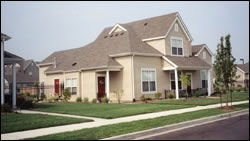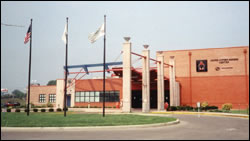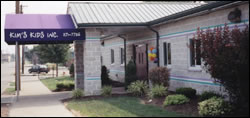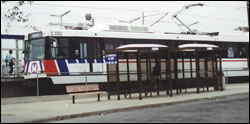East St. Louis: One City's Story
“You don't have to look far in East St. Louis to see something profound has happened there.”
Andrew Theising, associate political science professor at Southern Illinois University Edwardsville, was telling the story of East St. Louis' tumble into impoverishment to the audience at the St. Louis Fed's fall conference. (See main story on conference.)

Parson's Place, with 174 townhomes, is in the Emerson Park neighborhood.
The city's dilapidated landscape attests to his statement. Although it's hard to see the city the way it once flourished, there are some indications, such as new housing and stores, that East St. Louis could make a comeback. But first, what happened there?
At the turn of the century, East St. Louis was a thriving industrial town built by the “great capitalists,” including Andrew Carnegie and J.P. Morgan. The railroad played a major role in its economic growth. Factories ran 24 hours a day. Jobs were plentiful. The population not only grew, but doubled each decade through the first half of the 1900s. In 1959, the National Civic League named East St. Louis an All-America City, honoring its culture of civic excellence and the cooperative spirit among residents, businesses, nonprofits and government.
Ironically, by that time, East St. Louis was on the precipice of disaster. Industries had already begun to abandon the city for greater economic opportunities elsewhere. Between 1960 and 1970, the city lost nearly 70 percent of its businesses. Unemployment soared. Residents moved out of town. The population drain continued for years. Between 1970 and 2000, the city lost 55 percent of its population.

The Jackie Joyner-Kersee Center provides recreational and educational opportunities for youngsters from surrounding communities.
During all this time, inaction by an ineffective city government compounded the problems, Theising said. East St. Louis slipped into a downward spiral that has been tough to stop. As businesses left and the local government struggled, the tax base shrunk. As the tax base shrunk, the local government struggled more.
The city eventually had to eliminate all but basic city services, and even those were cut. The city couldn't pay its light bill or pay for its garbage collection. Street lights and stoplights were turned off, and abandoned lots became dumping grounds for trash. Police and fire protection was spotty, at best. Buildings began falling down. Crime and unemployment rose.
East St. Louis and devastation became synonymous.
Today, for most of the city's residents, things haven't changed much. Poverty is a way of life. However, in the last few years, organizations and investors have made headway in economic and community redevelopment. Concurrently, the population in the surrounding county has been growing dramatically, which Theising sees as good for the city.
“East St. Louis has too great a concentration of poverty,” he said. “We need to bring back a middle class.” As more people move near to and become familiar with East St. Louis, the more comfortable they will be with the city and what it has to offer, Theising said. He also said the city plays an important role in the revitalization of St. Louis, across the river.
The importance of creative partnerships in spearheading the growth that has occurred in East St. Louis was emphasized by Mark Olson,a member of the Board of Governors of the Federal Reserve System.
He cited the work of the federal government's Enterprise Community program, which has spurred collaboration among local government agencies and community organizations.
“The Enterprise Community has tapped federal, state and local resources to expand community development groups, provide workforce development programs and make infrastructure improvements,” he said.
Both existing businesses and new enterprises in East St. Louis have benefited from private-sector investments that were cultivated by the program, he said. One of the many outcomes was the construction of a new building for the city's oldest bank, Union Bank of Illinois (now First Bank).
Other partners that are committed to improving East St. Louis include the Casino Queen Foundation, which provided partial funding for Kim's Kids, a 24-hour day-care facility; the Jackie-Joyner Kersee Center, which provides educational and recreational programs for children; and the Metro East Lenders Group, a group of banks working together on economic development in East St. Louis and in nearby distressed cities.
One of the city's most effective partnerships is with the University of Illinois at Urbana-Champaign, which sponsors the East St. Louis Action Research Project (ESLARP). The project's goal is to nurture partnerships between community groups in the city and the students and faculty at the university.
Ken Reardon, former director of the project and currently an associate professor at Cornell University, is credited with establishing ESLARP, a revamped version of an earlier university program.
Reardon, who spoke at the Fed conference, echoed what others had to say: Look to the leaders in the community. Those leaders, for Reardon, turned out to be long-time resident Ceola Davis and a group of her friends who were members of the Emerson Park Development Corp., a neighborhood organization.

Kim's Kids, a 24-hour child-care center, opened in 1992 at 1000 Gaty Ave. and expanded to two buildings in 1997.
“These were eight African-American women pledging to each other that they would show up for work every day to begin building a citizens' movement in East St. Louis that could transform a very old and a very difficult political system,” he said.
The group sought help from the university and also was instrumental in organizing a coalition of black churches to assist them. Through the years, they were able to develop partnerships among local community-based organizations, public agencies and university students and faculty.
Early on, it was evident to Reardon that Davis and her friends had dealt with the university before and that they weren't in the market for another university study. At their first meeting with him in 1990, they outlined what it would take for them to work with the university:
- Residents, not the university, would decide which issues to tackle.
- Residents would be involved in every part of the planning and development process.
- The university would actively participate in projects, not just collect data for a study. (Davis showed Reardon 61 reports that the University of Illinois had done on East St. Louis between 1956 and 1990 at a cost of $13 million to taxpayers. Not one had resulted in a benefit to her neighborhood, she said.)
- The university would commit to a long-term partnership, a minimum of five years—after a probation period of one year.
- The university would help create a community-controlled, nonprofit independent organization to provide technical assistance to neighborhood groups. This would ensure support for the residents if the university ever pulled out.
Together, the Emerson Park group and Reardon and his students came up with an award-winning community development plan. There was one problem. No one would fund it. In the end, 30 regional agencies turned them down.
The lack of interest was no surprise to Davis, who convinced Reardon that they should start community redevelopment on their own, with a cleanup of one street in the Emerson Park neighborhood.
A large group of volunteers collected trash along the main street through Emerson Park. Because there were no funds to have it hauled away, they piled bags of trash in the middle of the street. A local television station did a story on the volunteers' plight, and by the next week the Emerson Park Development Corp. received a check for $15,000. It was the beginning of bigger and better things, Reardon said.
Over the course of the next summer, they used the money to haul away trash that volunteers cleared from hundreds of lots. They designed a playground and got a local church to build it. They fixed up and painted the outside of houses with paint the university donated.
The efforts of the neighborhood group and ESLARP drew the attention of the Illinois state treasurer, who worked out a plan for them to receive $75,000 in state funding. They used it to buy materials for more serious rehabs of houses. Habitat for Humanity workers offered their help and started a faith-based initiative in East St. Louis to construct new houses.
Eventually, ESLARP set up the Neighborhood Technical Assistance Center, which offers training in community organization, neighborhood planning, building and urban design, grant writing, digital technology and nonprofit management
From a weekend cleanup project in Emerson Park back in the early 1990s to ongoing multiple projects in various neighborhoods, ESLARP today is a model for an enduring university-community partnership. Its goal is to have a strong presence during its initial involvement in neighborhood organizations and a diminishing role as the organization becomes stronger.
The Emerson Park Development Corp. has evolved into a well-run neighborhood organization capable of bringing about major changes. An impressive example is the MetroLink (light-rail system) stop in Emerson Park, Reardon said. Original plans for the extension of the light-rail line called for trains to bypass the neighborhood. Undeterred by the fact that the plans were already drawn, the development corporation persuaded the powers-that-be to reroute the trains and put a stop in Emerson Park. Since then, the corporation has partnered with McCormack Baron & Associates to build affordable housing near the stop.
"Everyone had written off this city," Reardon said. "But it just took one dedicated woman to start bringing people together to do the impossible."
"If we can create this kind of long-term, sustainable partnership for real development here in East St. Louis, what can we accomplish in the rest of the region? We can do whatever we set our minds to."
Bridges is a regular review of regional community and economic development issues. Views expressed are not necessarily those of the St. Louis Fed or Federal Reserve System.
Email Us
All other community development questions





